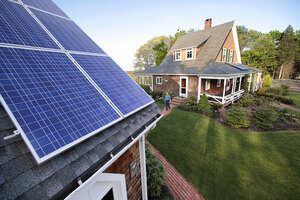New Obama climate push: Let them make power
The White House unveiled a package of energy initiatives Monday that emphasize an oft-overlooked component of the 21st-century energy shift: namely, that more and more everyday citizens are producing their own electricity.

A resident walks from his house to his garage where his solar energy panels are mounted on the roof in Marshfield, Mass.
Stephan Savoia/AP/File
Energy in the 21st century is slowly but surely shifting from centralized, emissions-heavy generation to decentralized, cleaner generation. The US government hopes to nudge that transition along by incentivizing businesses and homeowners to play a larger role in producing and consuming electricity.
That's the aim of a new climate and energy package released Monday by the White House. The new initiatives are modest, especially when compared to the sector-wide Clean Power Plan finalized earlier this month. But they emphasize an element of the 21st-century energy shift that is often overlooked in debates about our energy future: namely, that tomorrow's power won't just be cleaner or more efficient, it is also likely to be less concentrated in the hands of utilities and more distributed among everyday citizens across the country.
"We are seeing the beginning of this transformation," Energy Secretary Ernest Moniz said in a press call unveiling the initiatives Monday, "and we see a huge opportunity to expand it rapidly."
Emerging technologies like solar panels, smart thermostats, microgrids, and advanced batteries give consumers more information about their energy use, and give them more control over the flow of electrons that powers their everyday devices. Traditionally, electricity generation has been concentrated in the hands of massive power plants and the utilities that run them. That power is beginning to expand out into decentralized networks of solar panels, wind turbines, and energy storage sites across the country.
Still, these new forms of power face significant market barriers that have slowed their spread. That includes everything from the complexities of installing residential solar panels when so many Americans rent their homes, to figuring out how to pack more punch into a solar cell so that it can better compete with an energy-dense lump of coal. Despite much progress, producing their own power from solar panels remains relatively complicated and expensive for many Americans.
Monday's initiatives aim to chip away at those barriers. The Department of Energy is allocating $1 billion of its loan guarantee program specifically to projects that emphasize distributed generation. It has also announced $24 million for early-stage research into technologies that would double the amount of energy each solar panel can produce from the sun. The Department of Defense says it will spur deployment of solar panels across US military bases, and the Department of Urban and Housing Development plans to expand access to new clean-energy financing mechanisms. Later today, President Obama will discuss the plan in a speech at the eighth annual National Clean Energy Summit in Las Vegas.
It's all part of an effort to reduce US emissions by 26 to 28 percent below 2005 levels by 2025, and demonstrate to the globe that the world's second largest carbon-emitter is serious about combatting climate climate change. The Clean Power Plan, which will regulate carbon emissions from the nation's power plants for the first time in US history, should make a significant dent in that goal, but it will face significant challenges from the courts and Congress. With or without it, analysts suggest other steps will be needed to meet the nation's stated emissions targets.
There's a bit of a deadline, too: In December, delegates from nearly 200 countries will meet in Paris to finalize a global climate agreement. So far, less than a third of the nations involved have submitted their pledges in advance, but that number includes major emitters like the US and China.
"We are making sure that it's understood that we are prepared to push hard on distributed generation," Mr. Moniz said Monday.
Indeed, solar power has already made dramatic progress in recent years, aided by federal tax credits and other incentives at the state and local level. New solar installations grew by just over a third in 2014, according to the US Solar Energy Industries Association, with more than half of new solar photovoltaic growth happening in the residential sector. But as dramatic as that growth appears, solar power generation still represented only 0.4 percent of the US total last year, according to the US Energy Information Administration. Fossil-based power (coal, natural gas, and oil), on the other hand, accounted for 67 percent.

